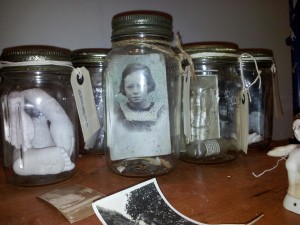I have recently read the proofs for the Norfolk Open Studios, and my listing says ‘Poem boxes juxtaposing word and image, using found and cast objects. 6×6, 8×8 inches.’ I only had 15 words to play with. There is also a photo of one of the boxes to give people an idea of what kind of creatures to expect. It says in the brochure that I will be in my studio, for people to visit from 9-5pm on the 1st-5th, and the 8th-10th June. That means it’s really happening. That means I have had the audacity of call myself an artist, and that I have invited everybody who wants to, to come into my studio to decide if that’s true. Perhaps I am being melodramatic. It’s still a big step though – considering I’ve only been making stuff seriously for about a year. Gulp. I am going to be part of an Art Trail, set up by local artist Emma Hart. I will be meeting up with some of the other artists soon to talk about how we might promote our particular trail. It’s all new to me, and I feel something of an outsider, though Emma has been very welcoming and lovely.
The photo below shows a bit of a departure from the box format. I acquired these old Kilner jars from my sister. They all have ‘Dual Purpose Jar’ on their lids, and I have taken them at their word. There is an antique/paraphernalia/vintage ephemera market on Magdalen Street in Norwich, in which I have lost many hours. Even if I don’t buying anything, it keeps me more entertained and enthralled than any walk round a museum or regular shopping trip. I bought the hand-tinted photograph of the little girl (below) about four years ago from there, and have recently been picking up some more old photographs for this series which I am calling ‘Preserves’. They are all of women, or girls, and I just find it incredibly moving that the occasion for a lot of them was quite intimate. They are often smiling or looking into a camera held by somebody they love and who loves them. (or this is what I imagine) The moment is held in time, and now I can pick up these images for as little as 75p.
By using them in this way, I feel as if I am saving them, bringing them back to life albeit in a totally different context. In the jars, I am also putting other objects such as pearls, old medicine bottles, moth wings, and each is labeled with a caption from an Aurthur Mee Encyclopedia. The little girl in the centre has torn moth wings on the floor of her jar, and her label reads: ‘How can we foretell an eclipse of the sun?’. I think of these as sketches for whole stories, and while removing images of these people from their original stories, which I can never know, I am creating a new one for them. And as John Berger says much more eloquently: “Those who read or listen to our stories see everything as through a lens. This lens is the secret of narration, and it is ground anew in every story, ground between the temporal and the timeless.’

